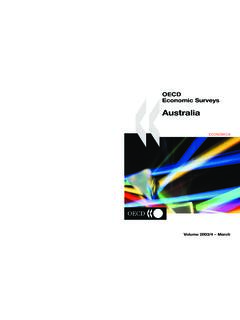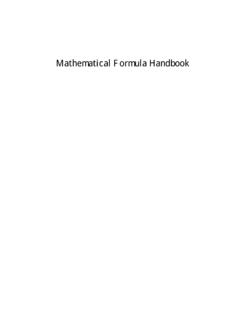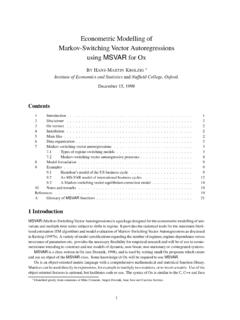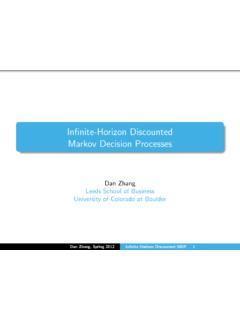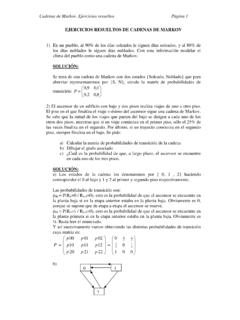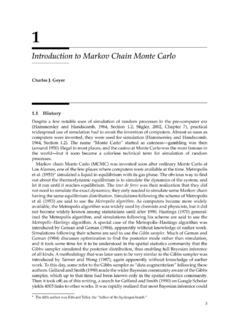Transcription of LECTURE ON THE MARKOV SWITCHING MODEL
1 LECTURE ONTHE MARKOV SWITCHING MODELCHUNG-MING KUANI nstitute of EconomicsAcademia SinicaThis version: April 19, 2002c Chung-Ming Kuan (all rights reserved).Address for correspondence: Institute of Economics, Academia Sinica, Taipei 115, : URL: Introduction12 The MARKOV SWITCHING MODEL of Conditional A Simple MODEL .. Some Extensions .. MARKOV Trend ..63 MODEL Quasi-Maximum Likelihood Estimation .. Estimation via Gibbs Sampling ..94 Hypothesis Testing for SWITCHING Parameters .. Testing Other Hypotheses ..135 Application: A Study of Taiwan s Business Cycles146 The MARKOV SWITCHING MODEL of Conditional Variance187 Application: A Study of Taiwan s Short-Term Interest Rates218 Concluding Remarks26 Appendix I: Estimation of the MODEL ( )27 Appendix II: Computation of Hansen s Statistic ( )29 References30c Chung-Ming Kuan, 200211 IntroductionIt is now common to employ various time series models to analyze the dynamic behav-ior of economic and financial variables.
2 The leading choices are linear models, such asautoregressive (AR) models, moving average (MA) models, and mixed ARMA linear time series models became popular partly because they have been incorpo-rated into many canned statistics and econometrics packages. Although these modelsare quite successful in numerous applications, they are unable to represent many nonlin-ear dynamic patterns such as asymmetry, amplitude dependence and volatility example, GDP growth rates typically fluctuate around a higher level and are morepersistent during expansions, but they stay at a relatively lower level and less persistentduring contractions. For such data, it would not be reasonable to expect a single, linearmodel to capture these distinct the past two decades, we have witnessed a rapid growth of the development ofnonlinear time series models; see , Tong (1990) and Granger and Ter asvirta (1993)for more thorough discussions. Nonlinear time series models are, however, not a panaceaand have their own limitations.
3 First, implementing nonlinear models is typically cum-bersome. For instance, the nonlinear optimization algorithms are easy to get stuck at alocal optimum in the parameter space. Second, most nonlinear models are designed todescribe certain nonlinear patterns of data and hence may not be so flexible as one wouldlike. The latter problem suggests that the success of a nonlinear MODEL largely dependson the data set to which it applies. An exception is the so-calledartificial neural networkmodelwhich, due to its universal approximation property, is capable of characterizingany nonlinear pattern in data; see , Kuan and White (1994). Unfortunately, thismodel suffers from the identification problem and is hence SWITCHING modelof Hamilton (1989), also known as theregime switch-ing MODEL , is one of the most popular nonlinear time series models in the MODEL involves multiple structures (equations) that can characterize the time se-ries behaviors in different regimes.
4 By permitting SWITCHING between these structures,this MODEL is able to capture more complex dynamic patterns. A novel feature of theMarkov SWITCHING MODEL is that the SWITCHING mechanism is controlled by an unobserv-able state variable that follows a first-order MARKOV chain. In particular, the Markovianproperty regulates that the current value of the state variable depends on its immediatepast value. As such, a structure may prevail for a random period of time, and it will bereplaced by another structure when a SWITCHING takes place. This is in sharp contrastwith the random SWITCHING MODEL of Quandt (1972) in which the events of switchingc Chung-Ming Kuan, 20022are independent over time. The MARKOV SWITCHING MODEL also differs from the models ofstructural changes. While the former allows for frequent changes at random time points,the latter admits only occasion and exogenous changes. The MARKOV SWITCHING MODEL istherefore suitable for describing correlated data that exhibit distinct dynamic patternsduring different time original MARKOV SWITCHING MODEL focuses on the mean behavior of variables.
5 Thismodel and its variants have been widely applied to analyze economic and financial timeseries; see , Hamilton (1988, 1989), Engel and Hamilton (1990), Lam (1990), Garciaand Perron (1996), Goodwin (1993), Diebold, Lee and Weinbach (1994), Engel (1994),Filardo (1994), Ghysels (1994), Sola and Driffill (1994), Kim and Yoo (1995), Schallerand van Norden (1997), and Kim and Nelson (1998), among many others. Recently, thismodel has also been a popular choice in the study of Taiwan s business cycles; see Huang,Kuan and Lin (1998), Huang (1999), Chen and Lin (2000a, b), Hsu and Kuan (2001)and Rau, Lin and Li (2001). Given that the MARKOV SWITCHING MODEL of conditionalmean is highly successful, it is natural to consider incorporating this SWITCHING mecha-nism into conditional variance models. A leading class of conditional variance modelsis the GARCH (generalized autoregressive conditional heteroskedasticity) MODEL intro-duced by Engle (1982) and Bollerslev (1986).
6 Cai (1994), Hamilton and Susmel (1994)and Gray (1996) study various ARCH and GARCH models with MARKOV SWITCHING . So,Lam and Li (1998) also introduce MARKOV SWITCHING to the stochastic volatility MODEL ofMelino and Turnbull (1990), Harvey, Ruiz, and Shephard (1994), and Jacquier, Polsonand Rossi (1994). Other financial applications of SWITCHING conditional variance modelsinclude, among others, Hamilton and Lin (1996), Dueker (1997), and Ramchand andSusmel (1998). Chen and Lin (1999) and Lin, Hung and Kuan (2002) also apply thesemodels to analyze Taiwan s financial time LECTURE note is organized as follows. In Section 2, we introduce a simple Markovswitching MODEL of conditional mean and its generalizations. We then study two esti-mation methods (quasi-maximum likelihood method and Gibbs sampling) in Section 3and discuss how to conduct hypothesis testing in Section 4. Section 5 is an empiricalstudy of Taiwan s business cycles based on a bivariate MARKOV SWITCHING MODEL .
7 Section 6presents the MARKOV SWITCHING MODEL of conditional variance. Section 7 is an empiricalanalysis of Taiwan s short term interest rates. Section 8 concludes this note. Readersmay also consult Hamilton (1994) for a concise treatment of the MARKOV SWITCHING a more complete discussion of this MODEL and its applications we refer to Kim andNelson (1999); computer programs (written in GAUSS by Kim) for implementingc Chung-Ming Kuan, 20023this MODEL are available from the web site: GAUSS programs written by Huang, Hsu and the author are alsoavailable upon The MARKOV SWITCHING MODEL of Conditional MeanNumerous empirical evidences suggest that the time series behaviors of economic andfinancial variables may exhibit different patterns over time. Instead of using one modelfor the conditional mean of a variable, it is natural to employ several models to representthese patterns. A MARKOV SWITCHING MODEL is constructed by combining two or moredynamic models via a Markovian SWITCHING mechanism.
8 Following Hamilton (1989, 1994),we shall focus on the MARKOV SWITCHING AR MODEL . In this section, we first illustrate thefeatures of Markovian SWITCHING using a simple MODEL and then discuss more generalmodel A Simple ModelLetstdenote an unobservable state variable assuming the value one or zero. A simpleswitching MODEL for the variableztinvolves two AR specifications:zt={ 0+ zt 1+ t,st= 0, 0+ 1+ zt 1+ t, st= 1,( )where| |<1 and tare random variables with mean zero and variance 2 . Thisis a stationary AR(1) process with mean 0/(1 ) whenst= 0, and it switches toanother stationary AR(1) process with mean ( 0+ 1)/(1 ) whenstchanges from 0to 1. Then provided that 16= 0, this MODEL admits two dynamic structures at differentlevels, depending on the value of the state variablest. In this case,ztare governed bytwo distributions with distinct means, andstdetermines the SWITCHING between these twodistributions (regimes).}
9 Whenst= 0 fort= 1,.., 0andst= 1 fort= 0+ 1,..,T, the MODEL ( ) isthe MODEL with a single structural change in which the MODEL parameter experiences one(and only one) abrupt change aftert= 0. Whenstare independent Bernoulli randomvariables, it is the random SWITCHING MODEL of Quandt (1972). In the random switchingmodel, the realization ofstis independent of the previous and future states so thatztc Chung-Ming Kuan, A Simple Model4may be jumpy ( SWITCHING back and forth between different states). Ifstis postulatedas the indicator variable1{ t c}such thatst= 0 or 1 depending on whether the valueof tis greater than the cut-off (threshold) valuec, ( ) becomes athreshold MODEL . Itis quite common to choose a lagged dependent variable (say,zt d) as the variable these models are all capable of characterizing the time series behaviors in tworegimes, each of them has its own limitations. For the MODEL with a single structuralchange, it is very restrictive because only one change is admitted.
10 Although extendingthis MODEL to allow for multiple changes is straightforward, the resulting MODEL estimationand hypothesis testing are typically cumbersome; see , Bai and Perron (1998) andBai (1999). Moreover, changes in such models are solely determined by time whichis exogenous to the MODEL . The random SWITCHING MODEL , by contrast, permits multiplechanges, yet its state variables are still exogenous to the dynamic structures in the MODEL also suffers from the drawback that the state variables are independent overtime and hence may not be applicable to time series data. On the other hand, switchingin the threshold MODEL is dependent and endogenous and results in multiple a suitable variable tand the threshold valuecfor this MODEL is usually adifficult task, approach to circumventing the aforementioned problems is to consider a differentspecification forst. In particular, suppose thatstfollows a first order MARKOV chain withthe following transition matrix:P=[IP(st= 0|st 1= 0) IP(st= 1|st 1= 0)IP(st= 0|st 1= 1) IP(st= 1|st 1= 1)]=[p00p01p10p11],( )wherepij(i,j= 0,1) denote the transition probabilities ofst=jgiven thatst 1= , the transition probabilities satisfypi0+pi1= 1.


